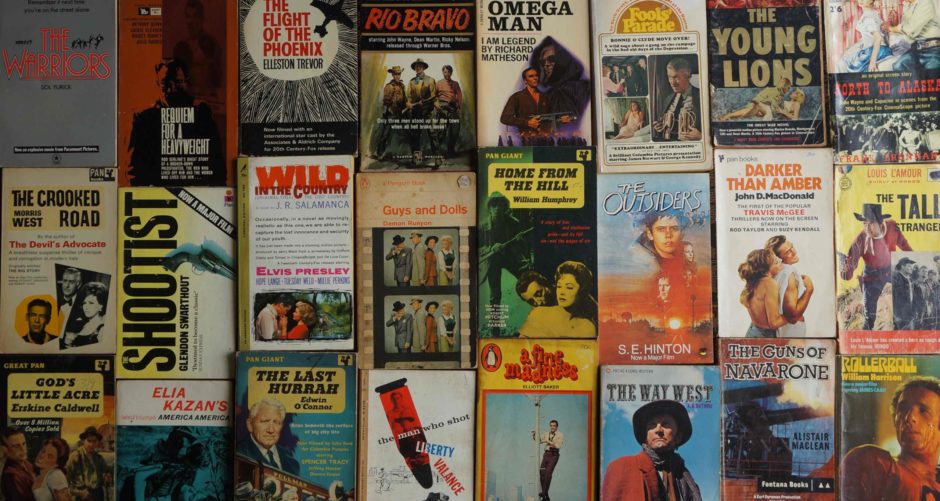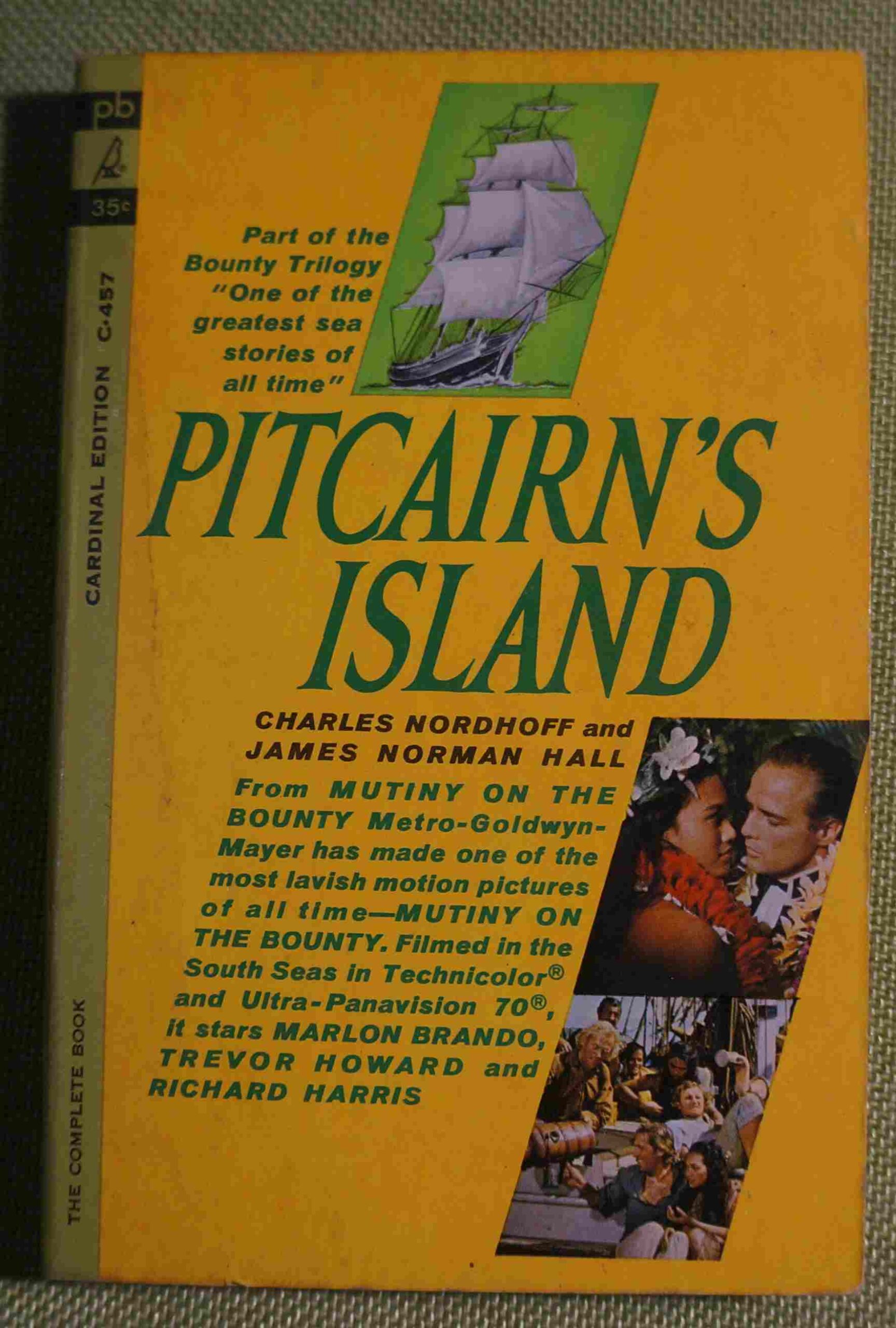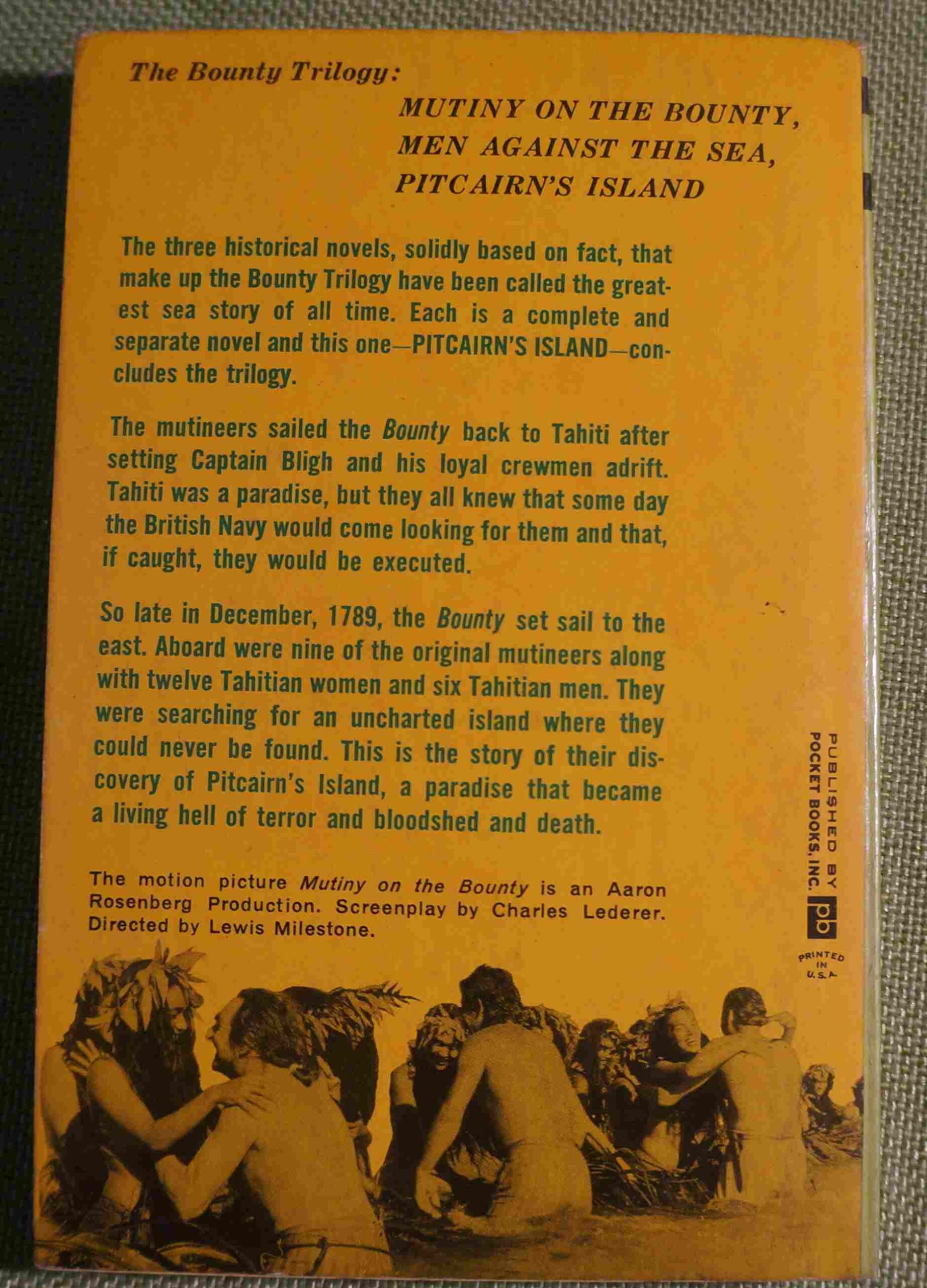FILM DIRECTOR: Lewis Milestone
SCREENWRITER: Charles Lederer
FILM STARS: Marlon Brando, Trevor Howard, Richard Harris, Hugh Griffith, Richard Haydn, Tarita Teriipaia, Matahiarii Tama, Percy Herbert, Duncan Lamont, Gordon Jackson, Chips Rafferty, Noel Purcell, Ashley Cowan, Eddie Byrne, Tim Seely, Frank Silvera, Henry Daniell, Torin Thatcher.
COUNTRY: USA
THIS BOOK
AUTHOR: Charles Nordhoff and James Norman Hall
TYPE: Novel
PUBLISHER: Pocket Books
THIS EDITION PUBLISHED: 1962
COUNTRY: USA
COVER: Paperback
THE ORIGINAL BOOK
ORIGINAL AUTHOR: As Above
YEAR FIRST PUBLISHED: 1934
ORIGINAL BOOK TITLE: Pitcairn’s Island
NOTES
GENRE: Historical
WORDS:
One of those movies I grew up with but didn’t really fully appreciate till much later because of technology.
Hear me out.
My mother loved this film. Partially because of the film and partially because my father took her to see it when they were dating. She loved my father, and said she fell in love with Marlon Brando after seeing this film. She married my father.
The film, not without fault, is an “experience” as only old Hollywood could do. Lots of money, name actors, real locations (not all the actual locations but close enough real ones (French Polynesian islands of Tahiti, Bora Bora, and Moorea)), hugh sets (the ship), no CGI.
It is hard not to be impressed by the film.
The first time I saw it back in the 80s on TV I liked it and then I saw it on a big screen TV in hi-definition DVD. It was twice as good.
Perhaps seeing it on the big screen would double my pleasure again.
Talking to normal people over the years the general malaise to old films you find I believe largely comes from the fact that contemporary films are either seen on the big screen whilst “old” films are seen on a TV. It will never be a fair race. I recall seeing a remastered Casablanca (1942) on the big screen as well as the remastered James Stewart – Alfred Hitchcock films some time in the 80s when they were re-released for mainstream (as opposed to art house) release. People were cheering and clapping like they were watching a Die Hard film. Okay those specific ol films are superior but even an average old film will look better on the big screen and will, I think, out shine newer films. There was more care in the craft.
Granted we have access to big screen TVs nowadays but unless you search out the remastered DVD you are watching an old film blown up to fit the screen. It doesn’t compare well in clean images to modern films. Sure, it shouldn’t matter, and matters ZERO to me, but to most people it puts the older films on a back foot.
And, though it matters zero to me, Mutiny on the Bounty looked better to me when I rewatched it on a bigger screen. Maybe I was older, maybe I was in a better mood, maybe I had a glass of wine with me, or maybe it’s just better on a bigger screen with a cleaner image.
The story of the Bounty mutiny may be well known within English naval history but I suspect it was Hollywood that made it into a well known story.
Putting aside the 1933 Australian film In the Wake of the Bounty (1933) with Errol Flynn in his first role which is largely unseen and almost unwatchable because of a small budget and a Flynn who hadn’t learnt to be Flynn yet, there are three major Hollywood versions (There was also an obscure (now lost) Australian silent version The Mutiny of the Bounty (1916) with Wilton Power (as Fletcher Christian) and George Cross (as Captain Bligh)).
Mutiny on the Bounty (1935), directed by Frank Lloyd, starring Clark Gable (as Fletcher Christian) and Charles Laughton (as (Captain Bligh) and with Franchot Tone, Eddie Quillan and Donald Crisp in support (James Cagney (then on a hiatus from Warner Bros. during a contract dispute) and future stars David Niven and Dick Haymes were uncredited extras in the movie.) was a BIG box office hit (the highest grossing film of 1935) and won the Best Picture oscar for the year
Mutiny on the Bounty (1962), directed by Lewis Milestone, starring Marlon Brando (as Fletcher Christian) and Trevor Howard(as (Captain Bligh) with Richard Harris, Hugh Griffith, Gordon Jackson and Richard Harris in support was a popular box office failure. The film was the fifth highest-grossing film of 1962 grossing $13,680,000 domestically,earning $7.4 million in US theatrical rentals. However, it needed to make $30 million to recoup its budget of $19 million. It didn’t, meaning the film was a box office flop. https://en.wikipedia.org/wiki/Mutiny_on_the_Bounty_(1962_film)
The Bounty (1984), directed by Roger Donaldson, starring Mel Gibson (as Fletcher Christian) and Anthony Hopkins (as Captain Bligh) with Laurence Olivier, Edward Fox, Daniel Day-Lewis and Liam Neeson in support was also a box office flop.
When the films were made affects their outlook. The 1935 version ended with a positive patriotic scene for the British Royal Navy in the days of sail (Rule Britannia! was popular in Hollywood in the mid-late 30s The Charge of the Light Brigade (1936), Lives of a Bengal lancer (1935), Gunga Din (1939), Clive of India (1935), Wee Willie Winkie (1937), The Sea Hawk (1940) etc). The 1962 version ended with the romantic death of Fletcher Christian and the 1984 version ended with the nuts and bolts trial and legal exoneration of Bligh.
The 1935 film may strike modern viewers as dated and unrealistic. Bligh is depicted, at least on the Bounty, as a raving sadist, although he was in fact far from that (apparently). It’s entertaining though it’s simplistic in its good vs. evil storyline and there are many historical inaccuracies.
The 1984 film is the most realistic and accurate but it doesn’t have any emotional highs or the leading man charisma of the other versions. Mel is good but a bit overwhelmed (it was his first big budget international film).
The 1962 film, is for my taste the best version. Not without its inaccuracies it is balanced by good storytelling and adventure that the first version succeeds in doing so well and the nods to realism and nuance that the third version does well.
It is also the most epic, captivating and compelling version. The photography (by Robert Surtee) is stunning, the period costumes great, the pageantry and colors of the pacific take your breath away. They built a replica of the Bounty from the keel up, a feat truly remarkable (it is an exact copy in scale 90% the size of the original HMS Bounty and can be toured every summer in Marina del Rey Harbor in Los Angeles, CA). The music by Bronislau Kaper is superb and can measure up to the epic scores of Lawrence of Arabia (1962), El Cid (1961), King of Kings (1961) and Doctor Zhivago (1965) any day, especially “The Love Theme” which is haunting and beautiful. The film is long (178 minutes, the other two versions are both 132 minutes long) but the pace of the film flows very well and it doesn’t drag much. Well, once they reach the island (Pitcairn) and the love story kicks in it slows a little. Brando and Howard play well off each other and Richard Harris gives a fine performance (for me this is a true bonus – these three actors I love and actively watch everything they are in … and that can be hard work).
History:
The mutiny on the Royal Navy vessel HMS Bounty occurred in the South Pacific Ocean on 28 April 1789. Disaffected crewmen, led by acting-Lieutenant Fletcher Christian, seized control of the ship from their Captain, Lieutenant William Bligh, and set him and eighteen loyalists adrift in the ship’s open launch. The mutineers variously settled on Tahiti or on Pitcairn Island. Bligh navigated more than 3,500 nautical miles (6,500 km; 4,000 mi) in the launch to reach safety and began the process of bringing the mutineers to justice.
After Bligh reached England in April 1790, the Admiralty despatched HMS Pandora to apprehend the mutineers. Fourteen were captured in Tahiti and imprisoned on board Pandora, which then searched without success for Christian’s party that had hidden on Pitcairn Island. After turning back towards England, Pandora ran aground on the Great Barrier Reef, with the loss of 31 crew and four prisoners from Bounty. The ten surviving detainees reached England in June 1792 and were court-martialled; four were acquitted, three were pardoned, and three were hanged.
Christian’s group remained undiscovered on Pitcairn until 1808, by which time only one mutineer, John Adams, remained alive. Almost all of his fellow mutineers, including Christian, had been killed, either by one another or by their Polynesian companions. No action was taken against Adams; descendants of the mutineers and their accompanying Tahitians live on Pitcairn into the 21st century.
https://en.wikipedia.org/wiki/Mutiny_on_the_Bounty
The source material for the 1935 and 1962 film was the novel Mutiny on the Bounty (1932) by Charles Nordhoff and James Norman Hall in which Christian is a major character and is generally portrayed positively (more positively than in the 1982 film). The authors of that novel also wrote two sequels, one of which, Pitcairn’s Island (1934), is the story of the tragic events after the mutiny that apparently resulted in Christian’s death along with other violent deaths on Pitcairn Island. (The other sequel, Men Against the Sea (1933), is the story of Bligh’s voyage after the mutiny) This series of novels uses fictionalised versions of minor crew members as narrators of the stories.
Charles Lederer (who mainly wrote comedies (I Was a Male War Bride (1949), Monkey Business (1952), Gentlemen Prefer Blondes (1953), the much underrated Elvis Presley film Follow That Dream (1962)) also dabbled in hard crime dramas (Kiss of Death (1947), Ride the Pink Horse (1947), Tip on a Dead Jockey (1957)), sci fi (The Thing (1951)) and big budget entertainments (Ocean’s 11 (1960), Can-Can (1960)) wrote a balanced screenplay. Superior English spy and thriller novelist Eric Ambler had originally had a crack at writing the film based on all three novels. I assume he was chosen because he had written a number of good screenplays on all things military naval (The Cruel Sea (1953), Yangtse Incident: The Story of H.M.S. Amethyst (1957)), military men under stress (The Purple Plain (1954)), sea based (A Night to Remember (1958)) or sea based with trial (The Wreck of the Mary Deare (1959)).
Ambler says his brief was to make Fletcher Christian’s part as interesting as Bligh’s. MGM executives were unhappy with Ambler’s script, although the writer estimated he did 14 drafts. John Gay was signed to write a version in July 1960. Eventually, William Driscoll, Borden Chase (writing in August 1960), Howard Clewes and Charles Lederer wrote all the scripts. According to one report, Ambler did the first third of the film, about the journey, Driscoll did the second, about life on Tahiti, and Chase did the third, about the mutiny and afterwards. Gay wrote the narration. Lederer was included before filming was to begin.
https://en.wikipedia.org/wiki/Mutiny_on_the_Bounty
Only Lederer received on-screen credit. I doubt others would not have received a credit if the contributions were substantial
In any event producer Aaron Rosenberg said “the film would focus more on the fate of the crew after the mutiny, with Captain Bligh only in a minor role and the mutiny dealt with in flashback. “It was Brando’s idea”, said Rosenberg. “And he was right. It has always been fascinating to wonder what happened to the mutineers afterwards.” “The mood after the mutiny must be one of hope”, said Reed. “The men hope to live a different sort of life, a life without suffering, without brutality. They hope for a life without sick ambitions, without the pettiness of personal success. They dream of a new life where nobody is trying to outdo the next person.”
https://en.wikipedia.org/wiki/Mutiny_on_the_Bounty_(1962_film)
Marlon Brando eventually signed to play Christian (though he apparently considered playing Bligh) for a fee of $500,000 plus 10% of the profits. The stories of Brando being difficult on set, and not sure even, if he wanted to play Christian or Bligh, are famous but his Christian is the pinnacle of doomed romanticism. Brando plays him like some of his other film characters: a mid-century loner or rebel. The first half of the film he is Lt. Christian Diestl (The Young Lions (1958)) but English, before becoming Terry Malloy (On the Waterfront (1954)) but with good breeding, before becoming Napoleon (Desiree (1954)) with his lost love. He knows his duty but is not sure if the British navy the place for him, and he is conflicted between love and duty and honour. The films failure stalled Brando’s career but he is wonderful.
Trevor Howard (perhaps because he had worked so well and often with Carol Reed) was brought on as Bligh and his Bligh snarls and is vicious but perhaps no more than any Naval sea captain of the era. Interestingly though, after all this Bligh ended up as Governor of New South Wales in Australia and was involved in another mutiny, the Rum Rebellion, when in 1808, 400 soldiers of the New South Wales Corps marched on Government House and placed Bligh under arrest, as a result of him trying to regulate the rum trade in Australia that the military corps were involved in. He was imprisoned until 1810 before all but retiring to England and dying in 1817). Howard is, perhaps, one the most underrated of English actors and is, far better than his stage to screen contemporaries.
The rest of the cast was cast with, at least in the talking roles, with Irish (Richard Harris, Noel Purcell, Eddie Byrne), British (Richard Haydn, Tim Seely, Percy Herbert, Henry Daniell, Duncan Lamont, Torin Thatcher), Scottish (Gordon Jackson, Duncan Lamont), Welsh (Hugh Griffith) or Australians (Chips Rafferty, Duncan Lamont) … actors whose nationalities would have made up the ship’s crew at the time. Apart from American (Jamaican born) black actor, Frank Silvera, the natives are played by polynesians. The female romantic lead was played by a local Tahitian French Polynesian, Tarita Teriipaia. Allegedly Brando personally Tarita, to play his love interest. They married in 1962 and divorced in 1972. She never made another film. Marlon wanted her at home to raise the kids (allegedly).
British director Carol Reed (Odd Man Out (1947), The Third Man (1949), Outcast of the Islands (1952), Trapeze (1956). The Key (1958), Our Man in Havana (1959), The Agony and the Ecstasy (1965) ) was hired to direct.
After three months of filming on location Reed left because of gallstones and heat stroke apparently. It seems though that Reed was fired (or left) over shooting schedules, concerns about where the story was going, and on set tensions. (The great) Lewis Milestone (All Quiet on the Western Front(1930), The Front Page (1931), Rain (1932), The General Died at Dawn (1936), Of Mice and Men (1939), The Purple Heart (1944), A Walk in the Sun (1945), The Strange Love of Martha Ivers (1946), The Red Pony (1949), They Who Dare (1954), Pork Chop Hill (1959), Ocean’s 11 (1960)) was brought on board. Milestone was towards the end of his career (this proved to be his final film) but he could handle spectacle, big casts and sets, deal with temperamental actors and could bring things in on budget or reign things in (ultimately the film went went over budget)
“Reed was used to making his own pictures” said Milestone. “He was not used to producer, studio and star interference. But those of us who have been around Hollywood are like alley cats. We know this style. We know how to survive.”
https://en.wikipedia.org/wiki/Mutiny_on_the_Bounty_(1962_film)
Milestone later said he took it on as he thought it would be an easy assignment because they’d been on it for months and there couldn’t be much left to do. He subsequently found that they had only shot, with actors, only one seven-minute scene, where Trevor Howard issues instructions about obtaining breadfruit.
Despite all this what emerges is a a large, epic and engrossing film a testament to the benefits Hollywood studio film making.
The film tie-in here is the second part of the trilogy after the mutineers arrive on Pitcairn Island. I assume the first part (about the actual mutiny) was also released in a movie edition. The third part which concerns Bligh’s voyage which isn’t (largely) in the film I assume wasn’t. I haven’t read Pitcairn’s Island but it is what it is a fictional narrative history of the event and I assume it would be reasonable as authors Nordhoff and Hall wrote many books, together and separately, on the sea and the military.
The only thing left is to watch the film again … especially now that I have an even bigger big screen TV.
LINKS
TRAILER
Music from the film



yep re Kirk … no one pushes Kirk around. His Bryna Production Company was involved with (partially funded) POG ..and…